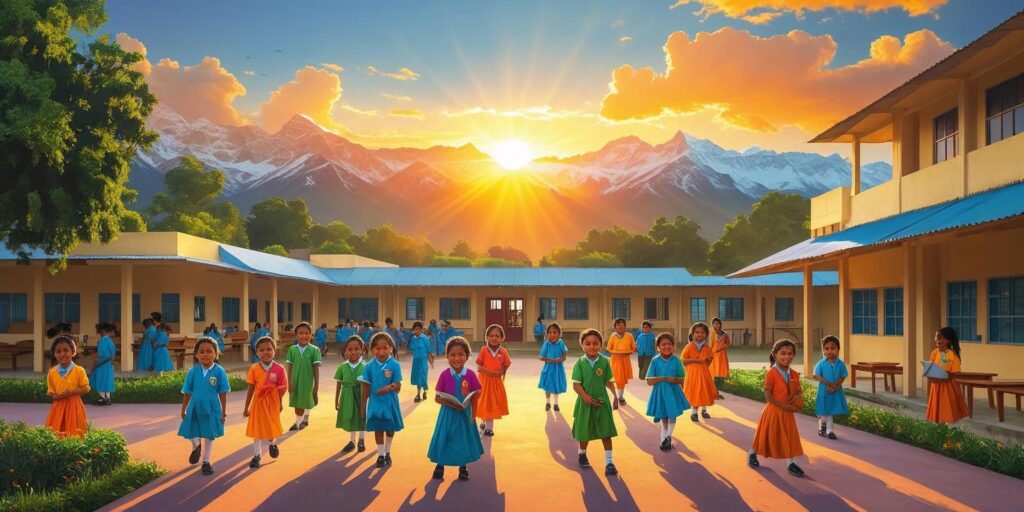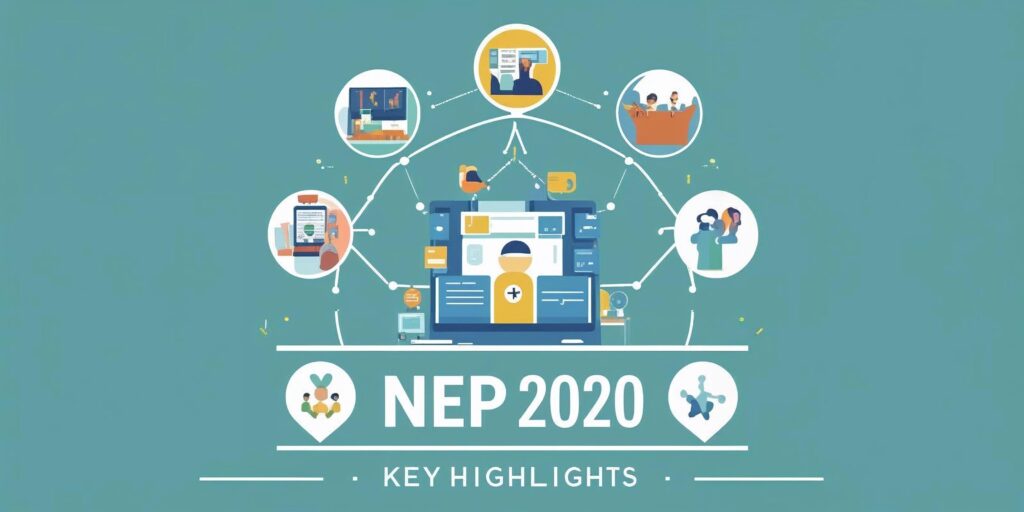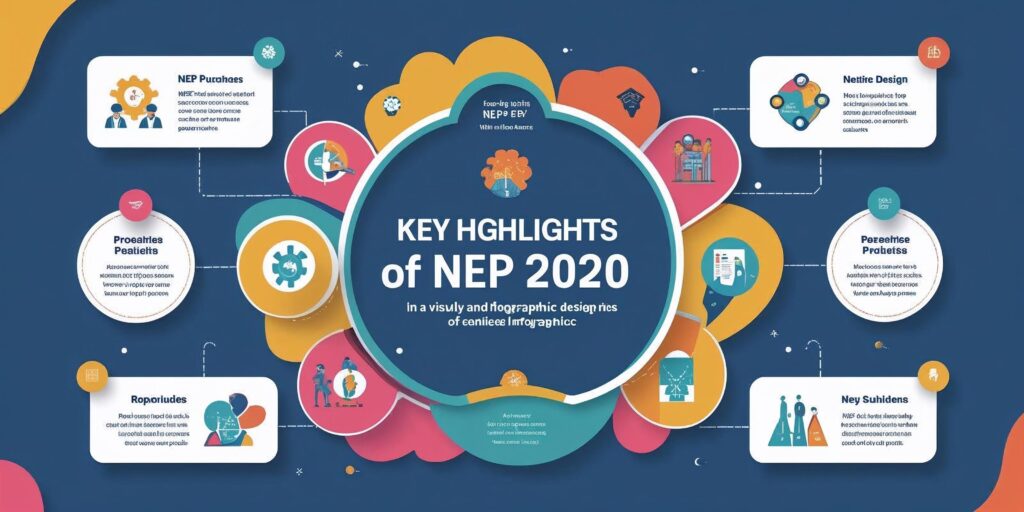How NEP 2020 Will Reshape Indian Education by 2030

Hi, Dear
Let’s be honest.
School in India has long felt like a race for marks.
Now, with NEP 2020, the story shifts.
Here’s the kicker: By 2030, learning is designed to be simpler, deeper, and more useful.
Kids start earlier (ages 3–6) in a playful and caring setup.
And the new 5+3+3+4 structure brings early childhood right into the formal system.
In the first years, classrooms use the home/local language, so understanding feels natural, not terrifying.
As a result, every child aims to read, write, and handle basic math with confidence—fast.
Next, assessments get smarter: less rote, more projects, portfolios, and problem-solving.
Arts, sports, coding, and vocational skills stop being “extras” and become part of the main meal.
Meanwhile, teachers get stronger training and lighter admin so they can focus on teaching.
On the flip side, memorization-only strategies won’t cut it; skills and competencies will.
Heading to college?
Think flexible, multidisciplinary degrees, multiple entry-exit options, and an Academic Bank of Credits that lets your learning travel with you.
Internships and real projects sit next to theory so you can fast track to being job-ready—for Indian students/professionals who want practical outcomes.
Pro tip: watch for more actionable, beginner-friendly pathways that turn a side hustle into a full-time job through stronger vocational exposure.
What this means for you: if you’re a student, expect clearer foundations and real-world skills.
If you’re a parent, expect joyful early learning and less exam anxiety.
If you’re a teacher, expect better support and autonomy.
That said, change takes time—but it’s moving.
Bottom line: NEP 2020 is a reset button for classrooms, campuses, and careers—working in 2025 and beyond.
In short, this is education that finally connects to life.
A New Dawn for Indian Education

When the National Education Policy (NEP) 2020 was announced.
It promised to transform how India learns, teaches, and evaluates.
For decades, our education system followed the same patterns—rigid structures, heavy rote learning, and limited career flexibility.
But the NEP 2020 has set an ambitious target.
By 2030, India will have a globally competitive, skill-driven, and inclusive education framework.
Why is this important now?
Because India is entering a phase where education quality directly impacts economic growth, innovation, and employability.
According to UNESCO, India will have the largest working-age population by 2030. And the skills we impart today will decide whether that’s a blessing or a missed opportunity.
This post will explore How NEP 2020 is shaping up.
What changes can we expect by 2030?
The challenges ahead and how students, parents, and educators can prepare.
NEP 2020 at a Glance

The NEP 2020 is India’s first education policy of the 21st century.
It is replacing the National Policy on Education, 1986.
It’s a comprehensive reform covering school education, higher education, teacher training, and technology integration.
Vision:
“To transform India into an equitable and vibrant knowledge society by providing high-quality education to all.” – Ministry of Education
Core Goals:
- Holistic, multidisciplinary learning
- Early childhood education
- Flexible curriculum with skill-based learning
- Stronger teacher training systems
- Digital and technology adoption
- 100% Gross Enrollment Ratio (GER) from preschool to secondary by 2030
Key Reforms Under NEP 2020

1. School Education Changes
The 5+3+3+4 structure replaces the old 10+2 format:
- Foundational Stage (5 years): 3 years of pre-primary + Grades 1–2
- Preparatory Stage (3 years): Grades 3–5
- Middle Stage (3 years): Grades 6–8
- Secondary Stage (4 years): Grades 9–12
Impact by 2030:
- Learning will start earlier with Early Childhood Care and Education (ECCE) for ages 3–6.
- The mother tongue or regional language will be the medium of instruction until at least Grade 5, improving conceptual clarity.
- Students will face less exam pressure with holistic report cards assessing skills, creativity, and critical thinking.
2. Higher Education Changes
By 2030, the NEP aims to have:
- Multidisciplinary universities offering arts, science, commerce, and vocational courses under one roof.
- Multiple entry and exit options in degree programs—students can leave after 1 year with a certificate, 2 years with a diploma, or continue to a full degree.
- Academic Bank of Credits (ABC): A digital record of earned credits, allowing flexible course combinations.
3. Vocational & Skill Education
- At least 50% of learners will get exposure to vocational education by 2030.
- Courses in coding, AI, agriculture, design, healthcare, and entrepreneurship will be introduced from the school level.
- Industry tie-ups for internships and apprenticeships will be standard.
Technology Integration in Education
The NEP envisions the National Educational Technology Forum (NETF) as the hub for edtech innovation.
By 2030, we can expect:
- AI-powered learning platforms that adapt to each student’s pace.
- Virtual and augmented reality classrooms for immersive learning.
- Expansion of online degree programs with UGC approval.
- Increased use of platforms like SWAYAM, DIKSHA, and NPTEL.
Here’s what to read next
Unacademy: The Ultimate Guide to India’s Most Popular Learning Platform
30 Best Online Learning Platforms
Teacher Training & Recruitment Reforms
The NEP sets high expectations for teachers:
- Mandatory 4-year integrated B.Ed. by 2030.
- Regular professional development programs to keep up with modern pedagogy.
- More autonomy in teaching methods while focusing on student engagement.
Why it matters: A motivated, well-trained teacher directly improves learning outcomes.
Impact of NEP 2020 by 2030
On Students
- Holistic development with a focus on critical thinking, creativity, and collaboration.
- More career flexibility with no rigid streams.
- Better global competitiveness due to skill-driven learning.
On Teachers
- Clear career progression paths.
- Opportunities for specialization in new-age subjects like AI, climate studies, and design thinking.
On the Economy
- Workforce ready for Industry 4.0 jobs.
- Boost to entrepreneurship and innovation.
- Alignment with Sustainable Development Goals (SDG 4 – Quality Education).
Challenges in Implementing NEP 2020
Even with strong goals, implementation faces hurdles:
- Infrastructure gaps in rural areas.
- Teacher shortages and uneven quality.
- Digital divide limiting online education access.
- Need for strong assessment reforms to match learning outcomes.
Top Scholarships for Indian Students in 2025
How Indian Students Can Use Google Scholar for Study Abroad Research Projects
Government Initiatives & Progress (2020–2025)
The Ministry of Education reports:
- Over 70% of states have initiated NEP-aligned school curricula.
- Digital learning platforms that expanded during COVID-19 have been integrated into mainstream education.
- Funding for vocational labs in 10,000 schools.
By 2030, the aim is universal school access and 100% GER in higher education.
International Comparisons
NEP 2020 aligns with:
- Finland’s model of holistic, no-exam stress learning.
- Singapore’s skills-first approach.
- Japan’s focus on early childhood and community-based education.
This global benchmarking ensures Indian students are globally competitive by 2030.
NEP 2020 vs Finland’s Education System
Both focus on:
- Holistic development
- Flexible curriculum
- Teacher autonomy
Difference: Finland has smaller class sizes and less exam pressure—a model NEP aims to approach by 2030.
Predictions for 2030 – NEP Outcomes
- Fully AI-enabled classrooms.
- 100% GER target achieved.
- Students graduating with dual degrees and industry-ready portfolios.
- Stronger industry-academia collaborations.
Conclusion on How NEP 2020 Will Reshape Indian Education by 2030—The Road Ahead
The NEP 2020 is not just a policy.
It’s a national commitment to make education relevant, inclusive, and future-ready.
If implemented effectively, by 2030 India could lead the world in educational innovation, skill development, and human capital.
As a student, parent, or educator, now is the time to adapt—explore online learning, embrace skill-based courses, and stay informed about policy updates.
Explore this related post
Boost Your Career with Free SWAYAM Certification Courses
Top 15 Career Courses for Indian Students
Top 25 Study Tips & Routines That Actually Work (2025 Guide)
FAQs – NEP 2020
What is the NEP 2020 to 2030?
NEP 2020 is India’s plan to transform education by 2030. It is shifting from rote learning to a flexible 5+3+3+4 system with early childhood care. It is mother-tongue teaching, skill-based and multidisciplinary learning, fairer assessments, stronger teacher training, and wider access from preschool to college.
Which of the following does NEP 2020 aim to achieve by 2030?
By 2030, NEP 2020 targets universal access to quality schooling. It is 100% gross enrollment from preschool to secondary. It also includes universal ECCE within the 5+3+3+4 structure and at least one large multidisciplinary higher-education institution in every district.
What is the future of education in 2030?
By 2030, education will be personalized, tech-enabled, and competency-based. It will blend classroom and online learning with AI tutors, flexible pathways and micro-credentials, continuous assessment. And also a strong focus on equity, foundational skills, employability, and lifelong learning.
Where will a program by 2030 be offered according to NEP 2020?
According to NEP 2020, by 2030 the 4-year integrated B.Ed. (teacher-education) programme will be offered only in multidisciplinary higher-education institutions/universities—not in standalone teacher-training colleges.
What is NEP 2020?
A government policy aimed at overhauling India’s education system for holistic, skill-based, and inclusive learning.
How will NEP 2020 change school education?
It introduces a 5+3+3+4 structure, early childhood education, and skill integration.
Will NEP 2020 replace board exams?
No, but board exams will be redesigned to test understanding, not memorization.
Is NEP 2020 implemented in all states?
Implementation is ongoing; some states are ahead, others are in the planning stage.
How will NEP 2020 affect higher education?
It will make degrees flexible with multiple entry-exit points and credit banks.







